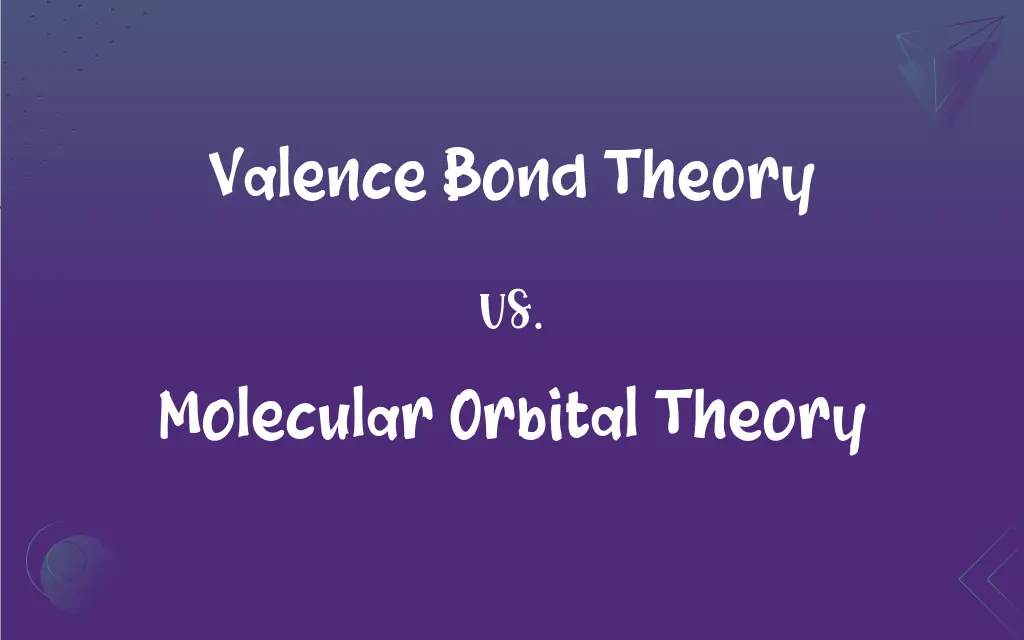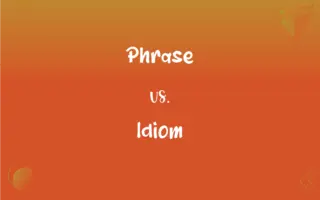Valence Bond Theory vs. Molecular Orbital Theory: What's the Difference?
Edited by Aimie Carlson || By Harlon Moss || Published on January 5, 2024
Valence Bond Theory explains chemical bonding through overlapping atomic orbitals and shared electron pairs, whereas Molecular Orbital Theory describes bonds as delocalized electrons in molecular orbitals formed from atomic orbitals.

Key Differences
Valence Bond Theory focuses on electron pairs in overlapping atomic orbitals to explain bonding, emphasizing localized bonds. Molecular Orbital Theory, on the other hand, considers electrons in molecules as delocalized over the entire molecule in molecular orbitals.
In Valence Bond Theory, bonds form from the overlap of half-filled atomic orbitals, creating localized electron pairs. Molecular Orbital Theory describes bond formation by combining atomic orbitals to form molecular orbitals, which can be bonding or antibonding.
Electron delocalization in conjugated systems like benzene is not adequately explained by Valence Bond Theory but is well-described by Molecular Orbital Theory through delocalized molecular orbitals.
Valence Bond Theory doesn’t inherently explain magnetic properties of molecules. Molecular Orbital Theory, however, can predict magnetic behavior by examining electron distribution in bonding and antibonding orbitals.
Valence Bond Theory focuses on bond strength through orbital overlap, while Molecular Orbital Theory provides a detailed view of energy levels and molecular stability through the arrangement of electrons in molecular orbitals.
ADVERTISEMENT
Comparison Chart
Bond Concept
Localized electron pairs in overlapping orbitals
Delocalized electrons in molecular orbitals
Electron Delocalization
Limited explanation for electron delocalization
Effectively explains electron delocalization
Magnetic Properties
Does not inherently explain
Can predict magnetic behavior
Orbital Hybridization
Emphasizes hybridized orbitals in bonding
Focuses on the combination of atomic orbitals
Energy Levels
Less emphasis on energy levels
Detailed view of molecular stability via energy levels
ADVERTISEMENT
Valence Bond Theory and Molecular Orbital Theory Definitions
Valence Bond Theory
Valence Bond Theory explains chemical bonding through overlapping of atomic orbitals.
The H2 molecule is described by the overlap of two hydrogen 1s orbitals in Valence Bond Theory.
Molecular Orbital Theory
Molecular Orbital Theory predicts electronic distribution in complex molecules.
The theory explains the delocalized electrons in benzene rings.
Valence Bond Theory
It focuses on localized electron pairs to form covalent bonds.
In water, Valence Bond Theory describes the O-H bonds as localized pairs.
Molecular Orbital Theory
It accounts for the magnetic properties of molecules.
Molecular Orbital Theory is used to explain why O2 is paramagnetic.
Valence Bond Theory
It emphasizes the electron pair as the main factor in bond formation.
Valence Bond Theory explains the double bond in ethylene as two pairs of shared electrons.
Molecular Orbital Theory
The theory provides a detailed view of molecular stability and energy levels.
Stability of the B2 molecule is explained by Molecular Orbital Theory.
Valence Bond Theory
Valence Bond Theory uses hybridization to explain molecular shapes.
The sp3 hybridization in methane is explained by Valence Bond Theory.
Molecular Orbital Theory
Molecular Orbital Theory describes electrons in molecules as delocalized across molecular orbitals.
In O2, Molecular Orbital Theory explains its paramagnetic nature.
Valence Bond Theory
The theory is useful for understanding the behavior of electrons in simple molecules.
Valence Bond Theory effectively describes the bonding in ammonia.
Molecular Orbital Theory
It forms molecular orbitals by combining atomic orbitals.
Molecular orbitals in H2 are formed by combining 1s orbitals from each hydrogen atom.
FAQs
What is the basic principle of Valence Bond Theory?
Valence Bond Theory is based on the idea of atomic orbitals overlapping to form localized bonds.
Can Molecular Orbital Theory predict magnetic properties?
Yes, it can predict the magnetic behavior of molecules based on electron distribution in orbitals.
How does Valence Bond Theory explain hybridization?
It explains hybridization as a mixing of atomic orbitals to form new, hybrid orbitals for bonding.
Is Valence Bond Theory effective for all molecules?
It’s effective for simple molecules but less so for molecules with delocalized electrons.
How does Molecular Orbital Theory handle delocalization?
It effectively explains electron delocalization across the molecule in molecular orbitals.
Can Valence Bond Theory describe resonance?
It can describe resonance but not as effectively as Molecular Orbital Theory.
Does Molecular Orbital Theory apply to all types of bonds?
Yes, it applies to single, double, triple bonds, and even metallic bonding.
What is the fundamental concept of Molecular Orbital Theory?
Molecular Orbital Theory describes chemical bonding using delocalized electrons in molecular orbitals.
How does Valence Bond Theory treat double and triple bonds?
It describes them as overlapping orbitals with different types of hybridization.
Is Valence Bond Theory suitable for predicting molecular shapes?
Yes, it’s quite effective in predicting the shapes of simple molecules.
How does Molecular Orbital Theory explain bond order?
Bond order is determined by the difference between bonding and antibonding electrons.
What role does electron delocalization play in Molecular Orbital Theory?
Electron delocalization is central, as it affects molecular stability and properties.
How does Molecular Orbital Theory view the electrons in a molecule?
It views electrons as delocalized over the entire molecule in molecular orbitals.
What are the limitations of Molecular Orbital Theory?
It can be complex and computationally intensive for large molecules.
In what way does Molecular Orbital Theory aid in understanding molecular spectra?
It helps in interpreting electronic transitions and spectral properties of molecules.
Is Valence Bond Theory useful in organic chemistry?
Yes, especially in understanding basic concepts of covalent bonding in organic molecules.
Can Molecular Orbital Theory explain chemical reactivity?
Yes, by analyzing the molecular orbitals, it can predict reactivity and stability.
Does Valence Bond Theory account for the strength of chemical bonds?
It gives a qualitative understanding of bond strength based on orbital overlap.
What is the significance of hybridization in Valence Bond Theory?
Hybridization is crucial for explaining the geometry and bonding of molecules.
Can Valence Bond Theory explain molecular polarity?
Yes, it can give insights into molecular polarity based on orbital overlap and electronegativity.
About Author
Written by
Harlon MossHarlon is a seasoned quality moderator and accomplished content writer for Difference Wiki. An alumnus of the prestigious University of California, he earned his degree in Computer Science. Leveraging his academic background, Harlon brings a meticulous and informed perspective to his work, ensuring content accuracy and excellence.
Edited by
Aimie CarlsonAimie Carlson, holding a master's degree in English literature, is a fervent English language enthusiast. She lends her writing talents to Difference Wiki, a prominent website that specializes in comparisons, offering readers insightful analyses that both captivate and inform.
































































